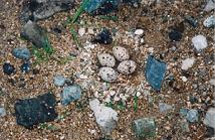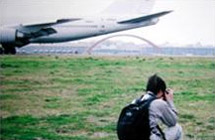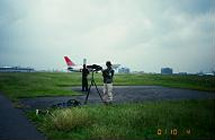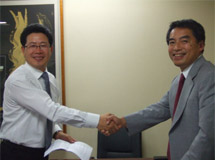08.07.31 以下、3つの情報をお伝えしています(日本語,English)。
(1) バードストライクに関する応用生物の取り組み
Efforts of Applied Biology Co. Ltd. regarding bird strike countermeasures
(2) 韓国からの業務依頼
Working for a South Korean airport
(3) 応用生物の活動が紹介された讀賣新聞記事
Summaries of some articles on our company’s work for bird strike Countermeasures appeared in Yomiuri Newspaper
(1) バードストライクに関する応用生物の取り組み
バードストライク(鳥と航空機との衝突)は、ライト兄弟が飛行機を開発して以来の問題で、およそ100年の歴史がある。日本でこの問題が本格的にとり上げられ、調査研究が始動したのは1977年である。
弊社は、そのスタートから現在までこの問題の解決のために活動してきており、30年の歴史がある。この間、国内20数空港の調査と防除手法の提案、ヨーロッパ、アメリカでの先進事例収集、国際ワークショップへの参加などの実績がある。日本ではすでに主要17空港で国の予算によるバードパトロールが行われているが、そのパトロール初任者に対する講義も毎年行っている。バードストライクの対策を考えるにはまず、空港の環境調査が必要である。

鳥の衝突で破損したファンブレード
|

空港内に産卵されたコアジサシの卵
|

空港内での植生調査 |

空港内での鳥類調査空 |
(2) 韓国からの業務依頼
韓国の空港で、改良工事に伴うアセスメントを実施することになり、同時にバードストライクの対策調査も行うことになった。しかし、韓国国内にはバードストライクの専門家がいなかった。そこで、韓国のコンサルタント会社が、インターネット等の情報によりバードストライクの専門家を探した結果、専門会社として応用生物が抽出され、弊社に依頼がきた。
平成20年5月から3年間の契約を結び、バードストライク対策調査を行うことになった。韓国のバードストライク対策の、モデルケースとなる重要な業務になるだろう。

契約成立
(1) Efforts of Applied Biology Co. Ltd. regarding bird strike countermeasures
Bird strike, collisions of bird with airplane, has been a problem since Wright brothers developed airplane and it has a history of approximately 100 years. In Japan, it was 1977 that studies of bird strike started being recognized as a serious problem. We have 30 years experience in working for solving the problem. Up to the present date, we researched over 20 airports and proposed preventive measures, studied the advanced cases of Europe and America, and took part in an international workshop.
Japan has already introduced bird patrol on a national budget at 17 major airports. As a part of training, we give a lecture for new staff of the patrol every year.
To plan a system of bird patrol, what we need to do first is to conduct a basic study of airport.

broken fan blade in collision with bird
|

little tern’s eggs laid in airport
|

vegetation survey in airport |

avian research in airport |
(2) Working for a South Korean airport
In South Korea, a study of bird strike countermeasures was requested when an environmental assessment was planned for improvement work of an airport. However, there was nobody who specialized in bird strike in the country.
That’s when a Korea consultancy started to seek someone who had the knowledge and experience in bird strike via internet.
As the result, they found our company as the bird strike specialty and contacted us to offer the work. In this May, we made a three year contract for the bird strike countermeasures, which is expected to be the model case in South Korea.

making the contract in South Korea
(3) 讀賣新聞に応用生物の活動が紹介される。
讀賣新聞にて、バードストライクの件で応用生物の活動が紹介されました。以下がその紹介された記事です。
7.10.2 讀賣新聞
中部国際空港(愛知県常滑市)の空港島に約1万羽のウミネコが飛来し、航空機に衝突するバードストライクが起きている問題で、空港会社が新手法のパトロールを導入した結果、ウミネコは滑走路周辺から姿を消した。
羽田空港などでバードストライク対策に実績のある自然環境コンサルタント「応用生物」(東京都港区)が9月中旬に現地調査を行った。同社の橘敏雄代表により新手法の対策を実施したことで、劇的な効果を発揮した。
橘代表は「ウミネコは人間のたくらみを見抜く高等動物で、直接危害が及ばないことを察知すれば、どんな手段も効果がなくなる」と話し、鳥の習性を読み、空港が安全でないことを知らせることが重要と指摘する。空港会社飛行場運用グループの葛谷茂芳リーダは「データを積み重ね、来年以降も万全を期したい」と話している。
07.11.28 讀賣新聞
中部国際空港の「ウミネコ退治宣言」から1か月半余り。一時は約1万羽が空港島をねぐらとする異常事態に、空港会社や航空会社などは大混乱に陥った。今回のウミネコ騒動など、航空機の安全運航の障害となる事態に、空港関係者はどう向き合うべきなのだろうか。(柴田永治)
航空機が1日約290回離着陸する滑走路周辺に日没後、最大約3000羽のウミネコが侵入して夜を過ごすようになったのは、夏のお盆すぎからだった。県が常滑市の海岸で毎年4回行っている出現数調査でも、昨年から増加しており、過去最も多かった1994年前後に並ぶ1万羽近くに達していた。空港会社は放水や車のサイレンを鳴らして追い立てたが、一時的に飛び立つだけで、車が帰るとほどなく舞い戻り、イタチごっこを繰り返した。
こうした事態に当初、滑走路南端にウミネコをとどめて、航空機に鳥が衝突するバードストライクを防ぐ「封じ込め作戦」がとられた。ところが、ウミネコは空港島を離れる気配を見せなかった。
空港会社から依頼を受けて対策に当たった環境コンサルタント「応用生物」(東京・港区)の橘敏雄代表の判断は、空港会社とはまったく逆だった。
「空港がウミネコにとって、安全な場所ではないことを知らせる必要がある。動物と人間が対峙するのは真剣勝負」というのが、国内や海外で野生動物のコントロールに長年の実績を持つ橘さんの持論だ。ウミネコの習性を知り、その逆手を取ってこそ効果があるというのだ。
橘さんらの調査・指導により、効果は確実に表れ、ウミネコは滑走路周辺から完全に姿を消した。
この間、ウミネコが退散するまで、バードストライクは計6回、着陸できず他空港に向かうダイバート5便、滑走路点検などで発着遅延は272便に及んだ。
今回のウミネコ騒動で、橘さんは「人間と動物との生活圏の境目をしっかりしておいて、初めて共生が成り立つ」と指摘した。
8.5.11 讀賣新聞
ウミネコ約1万羽の飛来で昨年夏、航空機に衝突するバードストライクが相次いだ中部国際空港(常滑市)で、本格的な飛来を前に空港会社が対策に乗り出した。すでに専門家を招いて鳥害対策会議を開いており、「今年は万全の態勢で臨みたい」としている。
同空港では昨年8〜9月に約一万羽のウミネコが押し寄せ、バードストライク6回、航空機の発着遅れが272便に達し、一時は空港機能がマヒ状態に陥った。
野生動物の生態に詳しい環境コンサルタント「応用生物」(橘敏雄代表)のアドバイスを受け、ウミネコ排除に成功した空港会社では今年4月に橘代表を招き、1回目の対策会議を開く徹底ぶりだ。
一方、国内最大のウミネコの繁殖地、青森県八戸市の蕪島では、今年も約4万羽が巣をつくり、今ごろが産卵のピーク。約20年間研究を続ける同県立八戸盲ろう学校の成田章教諭は「個体数は例年並みで、一つがいが2〜3個の卵を温め、7月上旬からは2万4000羽から2万8000羽が巣立ってエサを求めて南下をはじめるだろう」と話す。
このため、橘代表は空港周辺に飛来し始める初期段階の対応が重要なポイントと見て、6月からは個体数の動きの変化に、十分な注意を払うことなどをアドバイスした。「昨年効果があったからといって、同じ手が通用するとは限らない。鳥と人間の真剣勝負」と指摘する。
空港会社は「昨年は空港島がウミネコのねぐらになってしまったが、今年は同じ過ちを繰り返さない」と決意を語っている。
(3) Following are summaries of some articles on our company’s work for bird strike countermeasures appeared in Yomiuri Newspaper.
2 October 2007
Ten thousand of black-tailed gulls have disappeared from airstrips of Chubu International Airport in Tokoname City, Aichi Prefecture. Before that, the airport had been facing to a hardship of bird strike to airplanes.
In September, Applied Biology Co. Ltd., which has experience in bird strike prevention at Haneda Airports in Tokyo, carried out a field survey and introduced a new method at Chubu International Airport. It worked very well driving the birds away from the airport. According to the Managing Director of the company, Mr. Toshio Tachibana, it is important to know the bird behaviour and teach them the airport is not safe for their stay. “Gulls are intelligent birds to see through what we people plan. If they find a preventive method is not directly harmful to them, such a method will end in meaningless effort.” he said.
Mr. Shigeyoshi Tsutaya, the group leader of airstrip maintenance of the airport company said “We will make sure to overcome the problem in next year through continued data collection.”
28 November 2007
One and a half month have spent after the declaration of gull conquest at Chubu International Airport. The airport and airline companies had been panicked once 10,000 birds gathered at the airport island for roosting. How should the airport officials do for the problem to keep the flight safety?
It was this August that about 3,000 black-tailed gulls started to spend nights near the airstrips where about 290 airplanes took off or landed per day. According to surveys made by the Prefecture, the number of birds had been increasing since last year and reached 10,000, which was the maximum level of the number. The airport company tried to drive them away from the airport by discharging water and sounding car sirens; they took off but just came back after the cars left from the site. Then, the company took an enclosure measure to keep the birds at the edge of airstrips; but it did not work too. While no effective measure was taken, there were six times of bird strikes counted, five flights of diversion to force landing on other airports and 272 flights of delay for taking off or landing due to checking airstrips.
Being consulted to develop the countermeasure, Mr. Toshio Tachibana, the Management Director of Applied Biology Co. Ltd. had a totally different view from the airport company. He said “We need to teach them the airport is not a safe place for their life. It is fighting with real swords between men and animals.” His experience in working for animal control in and outside the country indicated we firstly need to know their behaviour and use it for the prevention. After surveys and instructions made by the consulting company, the birds disappeared completely from the airstrips. “Co-existence of people and wildlife can be realized only after demarcating each living area clearly” he added.
11 May 2008
An airport company for Chubu International Airport has started to prepare for bird strike that made a serious problem last summer before their arrival season. The company has already held the first meeting for the bird strike prevention, inviting Mr. Toshio Tachibana, the Management Director of Applied Biology Co. Ltd., which is a renowned consulting company for wildlife ecology and control.
It is a peak season for breeding of black-tailed gulls in Kabu Island, Aomaori Prefecture, known as the biggest colony of the birds in the country. According to a local researcher, the number of birds for breeding is about 40,000 this year and a pair of birds lays two to three eggs. It is predicted 24,000 to 28,000 young birds will start travelling toward the south for feeding in the early July.
Mr. Tachibana stressed it very important to take an appropriate measure during the time birds would start arriving at the airport and advised the airport company to carefully watch the change of their number from June. He said “Some method was effective last year but may not be necessarily so this year. It is fighting with real swords between people and birds.” An official of the airport company told that they would not repeat the same mistake as they did last year; the airport island should not be roosted by gulls this year.
<< TOPページに戻る
|
|